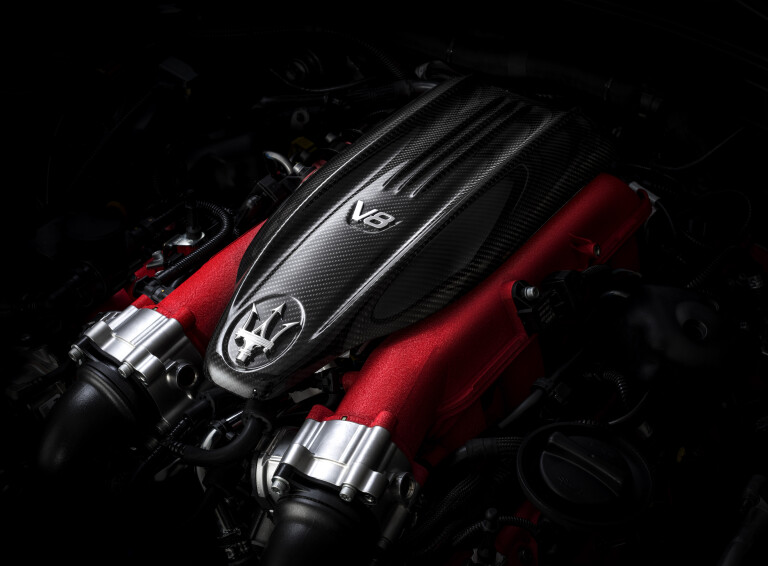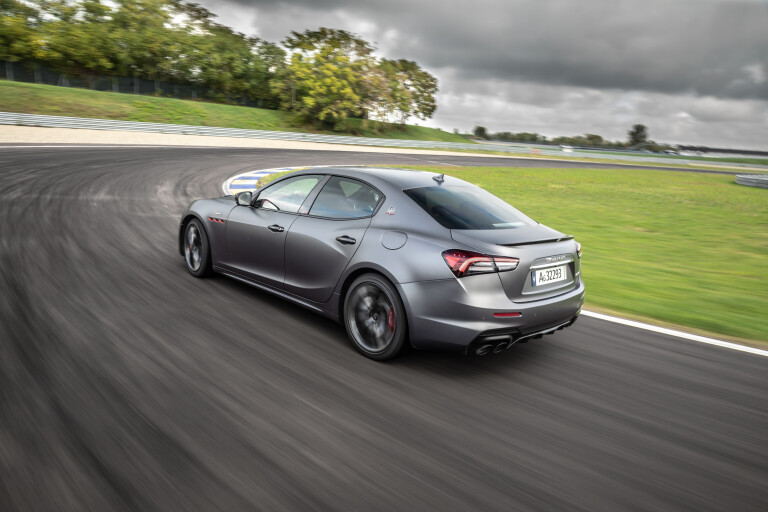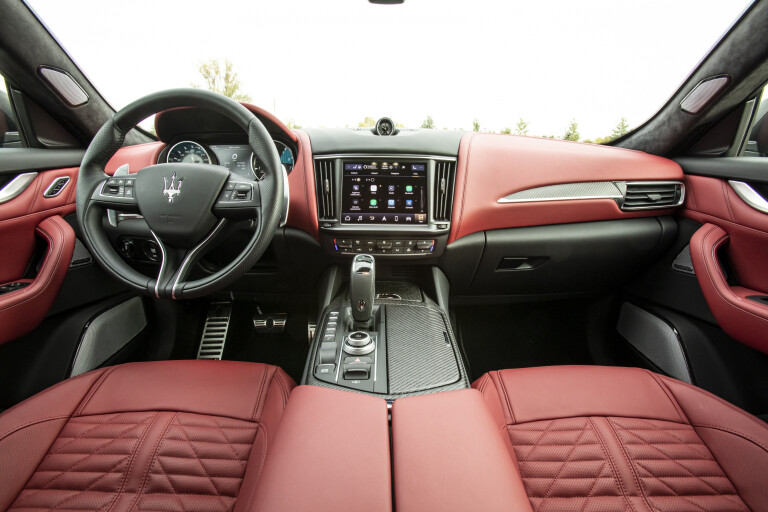
Things we like
- Drivetrain polish
- Touring ability
- Interior trim
- Ferrari connection
Not so much
- No individual drive mode
- Tame character
- Rear-seat packaging
Market research is a such a joyful and insightful guide to consumer behaviour, so we should try a little of it here. Let’s begin.
Raise your hand if you have over a quarter of a million burning a hole in your trousers and, hi-po SUVs be buggered, you’re ready to drop it on a full-size sports sedan.
Hold that hand high and steady if you’ve test-driven the likes of BMW’s M5, Mercedes-AMG’s E63 S and maybe Audi’s RS7 and rejected them on the basis of, I dunno, being too clever, too polished, too tech-heavy.
Now keep your hand up if you have a hankering for an Italian brand with a rich 106-year history, delivering a car with a twin-turbo V8 developed by Ferrari, driving the rear wheels only, and with a penchant for getting a little lurid and sideways when scruffed.
We’re tipping there aren’t many of you left with an arm extended, but maybe – just maybe – a select few to justify the effort Maserati has gone to so it can deliver this: the first V8-powered Ghibli since the original Tipo AM115 two-door built between 1967 and 1973.
This range-topping Trofeo variant at $265,000 is the pinnacle of a six-model line-up, starting at $145K for the 3.0-litre twin-turbo V6, and all recently refreshed with exterior updates, safety and assistance improvements, and extensive equipment upgrades.

None of which can alter the fact that this third-gen car debuted back in 2013, so accept that plenty of wrinkles can’t be ironed out with a shot of automotive Botox. Like a cabin that’s a world away from the tech-rich, screen-heavy future-fests of its German competitors.
The analogue main gauges are quaintly chrome-rimmed; there’s no head-up display, and as, we’ll get to, very limited tailoring of specific combinations of drive-mode parameters like engine mapping, steering weight and damper stiffness.
But the aromatic leather and glossy carbonfibre trim are lovely, and the hi-res 10.1-inch multimedia touchscreen is intuitive and responsive, with wireless Apple CarPlay that works seamlessly.
Just don’t look too hard at the HVAC controls and general switchgear and you may not notice they’re lifted from the Jeep/Chrysler parts bin, thanks to Stellantis’s ownership of the Italian brand.
Before firing up the Ferrari-built V8, it’s worth popping the bonnet for a little drool moment, because it really does look delicious. The intake plenums sit there proudly like scarlet, crackle-finished dog’s bollocks, neatly crowned with a slim carbonfibre shroud carrying the famed trident logo.
It makes the presentation of the M5’s 4.4-litre V8 seem like a bit of a shrinking violet by comparison, even if the BMW, in 460kW/750Nm Competition spec and priced at $246,900, does make use of its extra capacity to shade the 433kW/730Nm outputs of the Ghibli Trofeo.

"There’s no crazy aural fireworks under wide-open throttle, no metaphoric grenades lobbing out the back as you lift off"
Fire up the Maser, though, and those visual under-bonnet pops don’t translate to overt theatrics. This engine is a shorter stroke, cross-plane-crank, wet-sump version of the 3.9-litre V8 used by Ferrari in the Portofino and Roma models but with a far more neutered character.
Its idle is a distant, almost apologetic heartbeat, although hitting the sport button does open the exhaust valves for a slightly richer, more baritone woofle.
Throttle tip-in is nicely calibrated (unlike the over-servoed brake pedal), and the ubiquitous eight-speed ZF transmission is glitch-free and intuitive as it always is.
The V8 isn’t entirely lag-free – although what IC engine is, in this era of instant, pulverising EV torque – but gets properly percolating as the tacho swings toward 3000rpm, and has no trouble dealing with the Ghibli’s near-two-tonne mass when allowed to really work in the combat zone between 4000 and the 7200 limiter.
A quoted 0-100km/h acceleration time of 4.3 seconds is a bit off the pace of the all-wheel drive German rivals mentioned earlier, but it still feels lively in the extreme once on the move.
The lovely aluminium paddle shifters give fine control over the auto, and in manual mode, deny upshifts on the soft limiter. It’s a supremely slick, high-gloss drivetrain, with, to my mind at least, one crucial shortcoming: it’s too damn polite.
Even in the most extreme Corsa mode, which, by default, moves the dampers to their stiffest setting, there’s no crazy aural fireworks under wide-open throttle, no metaphoric grenades lobbing out the back as you lift off.

It leaves the Ghibli’s character a bit confused, as if it’s not quite sure what it’s trying to be.
Yes, it steers with a healthy degree of precision and conviction, and its pliant ride and noise suppression make it a fine, polished tourer. But surely if you forgo the technical sophistication of its German rivals, you want an Italian super sedan that, when prodded, becomes a bit of unhinged nut job.
Instead, the Trofeo seems oddly fixated on snuffing out extroverted brio with clinical efficiency. Yes, you can turn the ESC off and get it to reveal a sideways alter-ego, but it’s never a completely natural duality.
And given the Ghibli is in the twilight of its model cycle, time has run out to engineer in some of the sorely missing Latin mongrel.
It seems like a bit of a missed opportunity, we think, although we’ll concede Maserati’s market research into what customers really want may be more extensive than ours. Hands down.

2021 Maserati Ghibli Trofeo specs
- Engine: 3.8-litre V8, DOHC, 32v, twin-turbo
- Power: 433kW @ 6750rpm
- Torque: 730Nm @ 2250-5250rpm
- 0-100km/h: 4.3sec (claimed)
- Weight: 1969kg
- Price: $265,000 (before on-roads)

Things we like
- Drivetrain polish
- Touring ability
- Interior trim
- Ferrari connection
Not so much
- No individual drive mode
- Tame character
- Rear-seat packaging



COMMENTS